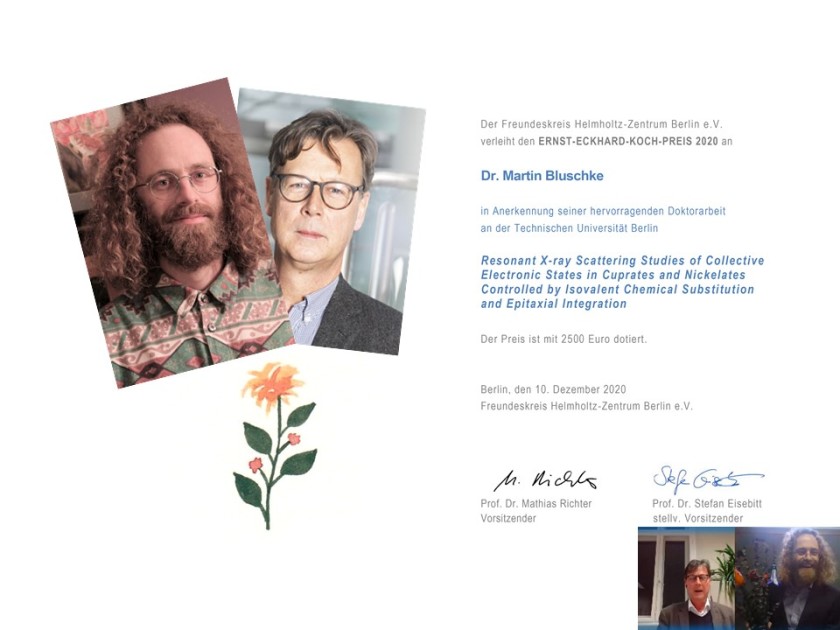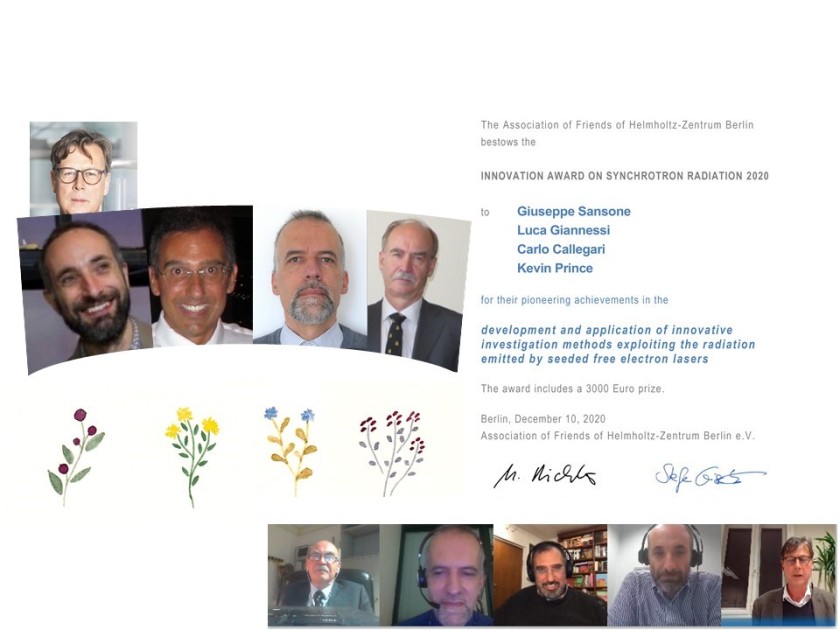Ernst Eckhard Koch Prize and Innovation Award Synchrotron Radiation

Martin Bluschke (MPI for Solid State Research, TU Berlin) receives the Ernst Eckhard Koch Prize from Mathias Richter for his outstanding dissertation. © Screenshot

The prize for innovation in synchrotron research went to Guiseppe Sansone, Luca Giannessi, Carlo Callegari and Kevin Prince. © Screenshot
This year, the Friends of HZB awarded the Ernst Eckhard Koch Prize to Dr. Martin Bluschke (MPI for Solid State Research and TU Berlin) for his outstanding doctoral thesis. The European Innovation Award for Synchrotron Radiation went to a team of four physicists for their work on the FERMI free electron laser at the Elettra synchrotron source in Trieste. The award ceremony took place at this year's HZB user meeting, which had to be held digitally this year.
The award ceremony was well attended with 197 spectators. The chairman of the Friends of HZB, Prof. Dr. Mathias Richter, led the award ceremony on screen and distributed hand-drawn bouquets of flowers as well as the award certificate. The prize committee had read the submitted proposals with great pleasure this year, he reported.
Ernst Eckhard Koch Prize 2020
The Ernst Eckhard Koch Prize went to Dr. Martin Bluschke, Max Planck Institute for Solid State Research in Stuttgart, who completed his doctorate in 2019 at the Technical University of Berlin. The title of his dissertation is: "Resonant x ray scattering studies of collective electronic states in cuprates and nickelates controlled by isovalent chemical substitution and epitaxial integration". Bluschke has been studying so-called collective states in solids at BESSY II, which are related to the phenomenon of superconductivity.
"Mr. Bluschke's dissertation reveals a deep understanding of physics. The numerous results are published to a high standard, which is also reflected by the number of citations," Richter quoted from the prize committee. Bluschke will continue his research at the University of British Columbia in Canada.
Innovation Award Synchrotron Radiation 2020
The Innovation Award Synchrotron Radiation 2020 went to Prof. Dr. Guiseppe Sansone (University of Freiburg), Dr. Luca Giannessi (Istituto Nazionale di Fisica Nucleare, Frascati, Italy), Dr. Carlo Callegari and Prof. Dr. Kevin Prince (Elettra, Trieste, Italy) for their achievements in the development and application of innovative investigation methods exploiting the radiation emitted by seeded free electron lasers at the FERMI free electron laser at Elettra in Trieste. The prize committee acknowledged "this development is of utmost importance for the future" and "concerns ground-braking experiments even on the attosecond scale". The Innovation Award Synchrotron Radiation is endowed with 3000 Euros and is sponsored by SPECS GmbH and BESTEC GmbH.
red.
https://www.helmholtz-berlin.de/pubbin/news_seite?nid=22401;sprache=en
- Copy link
-
Battery research with the HZB X-ray microscope
New cathode materials are being developed to further increase the capacity of lithium batteries. Multilayer lithium-rich transition metal oxides (LRTMOs) offer particularly high energy density. However, their capacity decreases with each charging cycle due to structural and chemical changes. Using X-ray methods at BESSY II, teams from several Chinese research institutions have now investigated these changes for the first time with highest precision: at the unique X-ray microscope, they were able to observe morphological and structural developments on the nanometre scale and also clarify chemical changes.
-
BESSY II: New procedure for better thermoplastics
Bio-based thermoplastics are produced from renewable organic materials and can be recycled after use. Their resilience can be improved by blending bio-based thermoplastics with other thermoplastics. However, the interface between the materials in these blends sometimes requires enhancement to achieve optimal properties. A team from the Eindhoven University of Technology in the Netherlands has now investigated at BESSY II how a new process enables thermoplastic blends with a high interfacial strength to be made from two base materials: Images taken at the new nano station of the IRIS beamline showed that nanocrystalline layers form during the process, which increase material performance.
-
Hydrogen: Breakthrough in alkaline membrane electrolysers
A team from the Technical University of Berlin, HZB, IMTEK (University of Freiburg) and Siemens Energy has developed a highly efficient alkaline membrane electrolyser that approaches the performance of established PEM electrolysers. What makes this achievement remarkable is the use of inexpensive nickel compounds for the anode catalyst, replacing costly and rare iridium. At BESSY II, the team was able to elucidate the catalytic processes in detail using operando measurements, and a theory team (USA, Singapore) provided a consistent molecular description. In Freiburg, prototype cells were built using a new coating process and tested in operation. The results have been published in the prestigious journal Nature Catalysis.
